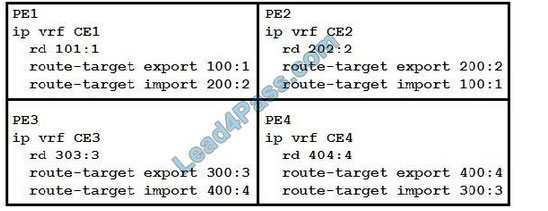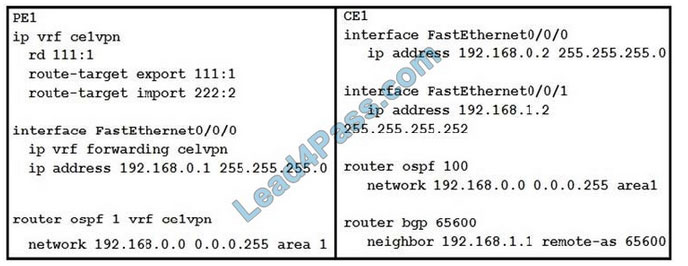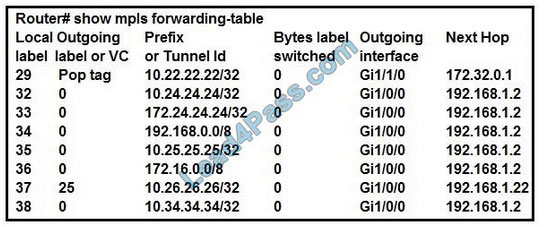The newly updated Cisco 300-515 dumps contain 71 exam questions and answers that candidates can study using the 300-515 dumps PDF and 300-515 dumps VCE to help you successfully pass the 300-515 SVPI exam.
You are welcome to download the latest Cisco 300-515 dumps: https://www.leads4pass.com/300-515.html, leads4pass 300-515 dumps serve all candidates taking the 300-515 SVPI exam and guarantee you 100% Successfully passed the 300-515 SVPI exam.
Download the Cisco 300-515 PDF for free sharing online:
https://drive.google.com/file/d/1ipBlMg9wu_hqz0OqZviiwm-JoFCVyptc/
Share the latest Cisco 300-515 dumps exam questions and answers for free
New Question 1:
Which two statements describe primary differencethe s between MPLS Layer 2 and Layer 3 VPNs? (Choose two.)
A. Layer 2 VPNs use IPsec tunneling, but Layer 3 VPNs use L2TPv3 tunneling.
B. Layer 2 VPNs use AToM, but Layer 3 VPNs use MPLS/BGP.
C. Layer 2 VPNs use BGP, but Layer 3 VPNs use VPLS.
D. Layer 2 VPNs use L2TPv3 tunneling, but Layer 3 VPNs use GRE tunneling.
E. Layer 2 VPNs use IPsec tunneling, but Layer 3 VPNs use pseudowires to provide tunneling.
Correct Answer: BD
New Question 2:

Refer to the exhibit. A network engineer has been called to configure the four PE devices in order to enable full communication among the four CE devices connected to them. While starting to configure, he experienced a connectivity issue. Which two tasks should the engineer perform in order to begin the process correctly? (Choose two.)
A. Configure PE3 to export route-targets 100:1 and 200:2.
B. Configure PE3 to import route-targets 100:1 and 200:2.
C. Configure PE4 to import route-targets 101:1 and 202:2.
D. Configure PE2 to export route-targets 300:3 and 400:4.
E. Configure PE1 to import route-targets 300:3 and 400:4.
Correct Answer: AB
New Question 3:

Refer to the exhibit. If the two devices are operating normally, which two conclusions can you draw from this configuration? (Choose two.)
A. CE1 must use OSPF to establish a neighbor relationship with PE1.
B. PE1 labels the routes it learns from CE1 with the route-target 222:2 and shares them with its VPNv4 peers.
C. PE1 labels the routes it learns from CE1 with the route-target 111:1 and shares them with its VPNv4 peers.
D. The PE-CE routes between the devices are being exchanged by OSPF
E. CE1 is supporting CSC.
Correct Answer: AD
New Question 4:
Which two frames can be configured on an Ethernet flow point? (Choose two.)
A. of a specific VLAN
B. with different type of service values
C. with identical type of service value
D. with different class of service values
E. with no tags
Correct Answer: AE
New Question 5:
An engineer is investigating an EVPN traffic flow issue. Which type of traffic should the engineer allow in an EVPN Tree Service in order to fix this issue?
A. known unicast from a leaf to another leaf
B. unknown unicast from a leaf to another leaf
C. multicast from a leaf to another leaf
D. known unicast from a root to another root
Correct Answer: D
Reference: https://tools.ietf.org/html/draft-ietf-bess-evpn-etree-14
New Question 6:

Refer to the exhibit. Which statement about this output is true?
A. The router IP 192.168.1.2 sent an implicit null, and the output is from the penultimate LSR.
B. The adjacent router is the egress LSR and has mpls ldp explicit-null configured.
C. The adjacent LSR router configured mpls label range 0.
D. The zero in the second column is the normal behavior of an egress router LSR.
Correct Answer: B
New Question 7:
An engineer is troubleshooting an ongoing network outage. Which command should he use that can display the live log files for a process or service running on a network device?
A. traceroute
B. show run
C. ping
D. debug
Correct Answer: D
New Question 8:
Which tool identifies the point of failure in a P2MP LSP from the ingress LSR?
A. Jitter TLV
B. SPAN
C. P2MP traceroute
D. P2MP ping
Correct Answer: C
New Question 9:
In a typical service provider environment, which two tools are used to help scale PE router connectivity requirements? (Choose two.)
A. route reflectors
B. VPNv4 address family
C. originator ID
D. cluster ID
E. confederations
Correct Answer: AE
New Question 10:
An ISP provides a major client MPLS VPN for managed services. The MPLS engineering team needs to use the advanced VPN feature of selective VRF import so that only specific prefixes are present in the required VPNs. Which aspect of this feature must the team consider?
A. A route must pass the import route map first and then the route target import filter.
B. The routers that are imported in the VRF can be BGP and IGP routes, so other match conditions in the route map, besides communities, can be used.
C. The import-map command is applied under the PE interface that connects to the CE router.
D. A route is imported into the VRF only when at least one RT that is attached to the route matches one RT that is configured in the VRF and the route is permitted by the import route map.
Correct Answer: D
Reference: https://www.ccexpert.us/mpls/configuring-selective-vrf-import.html
New Question 11:
While configuring the VRF Selection feature, you get an error message after typing the below statement:
Router(config)#no vrf selection source 172.16.0.0 255.255.0.0 vrf VRF1
Which action caused this message?
A. the entry of an inconsistent IP address and mask for VRF Selection
B. an attempt to configure a VRF instance on an interface that already has VRF Selection configured
C. an attempt to remove a VRF Selection entry that does not exist
D. an attempt to configure a VRF Selection table that does not exist
Correct Answer: C
New Question 12:
Which two BGP attributes prevent loops in a route reflector environment? (Choose two.)
A. cluster ID
B. local preference
C. origin
D. originator ID
E. AS_PATH
Correct Answer: AD
Reference: https://www.ciscopress.com/articles/article.asp?p=2756480andseqNum=10
New Question 13:
You try to configure MPLS VPN VRF Selection based on a source IP address on an interface that has VRF configured, but you receive an error. Which action must you take to correct the problem?
A. Change the source IP address.
B. Add the IP address to the VRF table.
C. Remove the VRF from the interface.
D. Configure static routes for the VRF.
Correct Answer: C
New Question 14:
The CTO of a company requires the support of a network consultant to deliver an MPLS solution without resigning to a certain degree of redundancy and scalability. Which solution effectively scales to hundreds or thousands of sites?
A. L2VPN with the broadcast traffic processed at the ingress PE.
B. L3VPN with direct LSP connectivity between all PEs.
C. L2VPN by encapsulating multiple frame formats with interworking.
D. L3VPN using a hierarchical topology of N-PEs and U-PEs.
Correct Answer: D
New Question 15:
You are troubleshooting ARP connectivity issues for an Ethernet interface on an IOS XR network that runs IS-IS. You verify that the IGP protocol is running, but an ARP entry has not yet been created. Which action should you take?
A. debug ping packets
B. debug ARP
C. ping the connected neighbor
D. verify the RIB table routes
Correct Answer: C
…
Download the Cisco 300-515 PDF for free sharing online:
https://drive.google.com/file/d/1ipBlMg9wu_hqz0OqZviiwm-JoFCVyptc/
The above is only a part of Cisco 300-515 dumps exam questions and answers, you can use the above exam questions and answers to improve yourself, not only that, we welcome you to download the latest Cisco 300-515 dumps exam questions: https://www.leads4pass.com/300-515.html (Total Questions: 71 Q&A), help you truly pass the 300-515 SVPI exam.